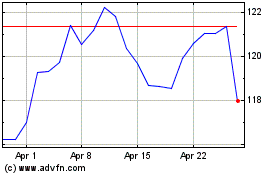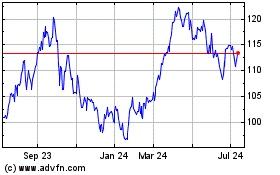SYDNEY—BHP Billiton Ltd. outlined a plan to expand its valuable
oil-and-natural-gas business, advancing new projects it says it can
develop at a fraction of the cost than previously expected to take
advantage of a projected recovery in global energy prices.
Petroleum operations President Steve Pastor on Wednesday said
BHP plans to be "patient and prudent" in growing the business, but
forecast oil investments to account for a greater share of its cash
flow. He added that the unit, weighed down in recent times by
struggling U.S. shale fields, is likely to be the mining company's
highest-margin division for years to come, outpacing commodities
such as iron ore.
For the world's No. 1 mining company, it is a sign of its
commitment to the oil-and-gas business that has set it apart from
most of its peers but failed to cushion BHP from a now-multiyear
downturn in metals markets. In August, BHP recorded its worst
annual loss to date, with weak oil and natural-gas markets one of
the biggest weights on its bottom line. BHP's petroleum business
incurred a loss of US$7.72 billion after write-downs linked to U.S.
shale assets BHP acquired in 2011.
U.S. mining company Freeport-McMoRan Inc. also branched out into
oil in recent years, but is now working to unload its energy
business to reduce its debt and refocus on producing copper.
BHP, which has run petroleum assets since the 1960s, has
"sharpened and strengthened" its oil-and-gas strategy over the past
two years, switching focus to "value over volume," Mr. Pastor told
reporters on Wednesday before an investor briefing.
That was "out of necessity, to be quite honest," said Mr.
Pastor, adding: "With oversupply, it has really compelled us to
work much more diligently."
A huge drop in drilling costs that has accompanied the oil-price
slump, coupled with internal measures to improve productivity
generally, are making major initiatives such as the roughly US$10
billion Mad Dog 2 deep-water project in the Gulf of Mexico more
appealing. "With significant improvements in capital efficiency,
major capital projects like Mad Dog 2 are now economically
attractive, even below US$50 per barrel of oil," Mr. Pastor
said.Mr. Pastor said an investment decision on Mad Dog 2 is
expected within the next six months. BHP has a 24% stake in the
site, which is 61% controlled by BP PLC. Chevron Corp. owns the
rest.
In the Eagle Ford Shale in south Texas, where BHP says it now
has a backlog of undrilled wells to tap, drilling costs have been
cut to less than US$1.5 million per well from about US$5.5 million
three years ago. Also in Texas, in the Permian Basin, BHP said it
now has access to more than one billion barrels of oil equivalent,
that could turn the field into the largest producer of barrels and
cash in the petroleum unit within five years.
Additionally, BHP isn't ruling out acquisitions, Mr. Pastor
said, adding: "It has to be at the right price and it has to play
to our strengths."
When Andrew Mackenzie became chief executive of BHP in 2013, he
designated oil and gas as one of four "pillars" of its business,
alongside iron ore, copper and coal.
Last year, the mining company carved out a suite of other
commodity businesses it no longer wanted, including manganese mines
and aluminum smelters.
The company previously said it planned to gear future
investments toward petroleum and copper instead of iron ore and
coal, where it spent heavily expanding its operations in recent
years.
For BHP, it is effectively a bet on rising demand for products
as diverse as refrigerators and cars in China and India.
On Wednesday, the company forecast oil demand will rise about 1%
a year over the next couple of decades.
Vast new supplies—equal to about one-third of current
demand—will be needed to fill the gap, as some existing fields dry
up, it said.
Earlier this year, oil prices slipped below US$30 a barrel for
the first time in more than a decade because of a global
glut.Prices, down from more than US$100 as recently as 2014, have
since sprung back to about US$50 a barrel and supply-and-demand
dynamics seem to suggest oil and gas markets will improve more
quickly than the other commodities BHP produces, Mr. Pastor
said.
BHP isn't alone in looking at growth.
Over the summer, Chevron Corp., Exxon Mobil Corp. and several
partners committed US$37 billion to expand an oil project in
Kazakhstan known as Tengiz. BP PLC is fast-tracking a major
offshore gas discovery in Egypt.
Historically, petroleum has been BHP's highest-margin business,
with an earnings margin of 64% over the past 15 years versus 42%
for the group, according to Macquarie Group. However, over the past
five years, since BHP acquired its shale assets, that margin has
been in steady decline and in the year through June, iron ore
overtook petroleum as the unit with the best margins, it said.
Mr. Pastor said petroleum would likely "maintain its position as
BHP Billiton's highest-margin business" over the longer run,
though, as it expands its most profitable assets.
Write to Rhiannon Hoyle at rhiannon.hoyle@wsj.com
(END) Dow Jones Newswires
October 05, 2016 13:05 ET (17:05 GMT)
Copyright (c) 2016 Dow Jones & Company, Inc.
Exxon Mobil (NYSE:XOM)
Historical Stock Chart
From Mar 2024 to Apr 2024

Exxon Mobil (NYSE:XOM)
Historical Stock Chart
From Apr 2023 to Apr 2024
